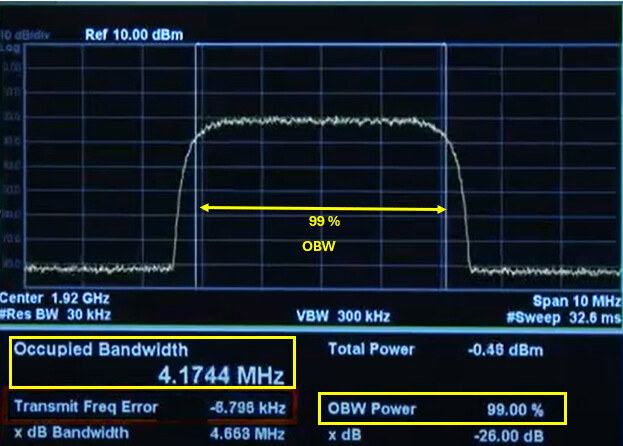Hello dear Experts,
What is the difference between Frequency Range, IBW and OBW?
Hello dear Experts,
What is the difference between Frequency Range, IBW and OBW?
Frequency Range: IBW and OBW refers to bandwidth defined by the frequency range within which the RU can be operated, defined by the band-pass filter of the BS, e.g. 3.4 – 3.8 GHz (400 MHz)
In all cases: Frequency Range > IBW > OBW
If a RF module has higher IBW and OBW, what does that means? What are the advantages to have high IBW and OBW? What are the disadvantages of having low IBW and OBW??
In accordance with 3GPP TS 34.121 Section 5.8, Occupied Bandwidth (OBW) refers to the minimum bandwidth encompassing 99% of the total integrated power within the transmitted signal’s spectrum. This bandwidth is centered on the assigned channel frequency, which is the specific frequency band allocated for your transmission in the 5G NR network.

fig reference : Keysight YouTube video
And the configuration values we need to do on signal analyzer are based on the table below.

reference 3gpp spec
Imagine the entire allocated channel for your 5G NR transmission as a spectrum with varying power levels across different frequencies. Occupied Bandwidth (OBW) refers to the portion of that spectrum that carries 99% of the total transmitted power.
Think of it like a box that captures the most significant part of the signal. This remaining 99% of the power is what actually carries the information you’re trying to transmit.
The table mentioned in (likely Table 6.5.1-1 from 3GPP specifications) defines the channel bandwidth, which is the total bandwidth allocated for your transmission. This includes some “fringe” areas where the power might be very low.

reference 3gpp -138.101
LinkedIn (and Source): ![]()
Instantaneous Bandwidth (IBW) and Occupied Bandwidth (OBW) are two related but distinct concepts in wireless communication.
Both terms refer to the bandwidth of a signal, but they differ in their perspective and application.
Instantaneous Bandwidth (IBW) refers to the bandwidth of a signal at a specific instant in time. It represents the range of frequencies that the signal occupies at a particular moment. Think of it like a snapshot of the signal’s bandwidth.
Example: Suppose you have a wireless signal with a carrier frequency of 1 GHz and a modulation scheme that produces a signal with a bandwidth of 10 MHz at a specific instant. The IBW of this signal would be 10 MHz.
Occupied Bandwidth (OBW) on the other hand, refers to the total bandwidth occupied by a signal over a specific period. It takes into account the signal’s bandwidth over a range of time, including any variations or changes in the signal’s frequency content.
Example: Using the same signal as above, if the modulation scheme changes over time, causing the signal’s bandwidth to vary between 8 MHz and 12 MHz, the OBW would be the range of frequencies occupied by the signal over that period, say 4 MHz (12 MHz - 8 MHz).
And there are key differences:
Example: To illustrate the difference, imagine a signal with a constant IBW of 10 MHz but varying OBW due to changes in modulation. The IBW remains the same, but the OBW changes over time.
So:
Find out also theses explanations from Rhode & Schwartz concerning OBW and IBW:
Watch Video on YouTube: ![]() https://www.youtube.com/watch?v=GmZItI66ToI
https://www.youtube.com/watch?v=GmZItI66ToI